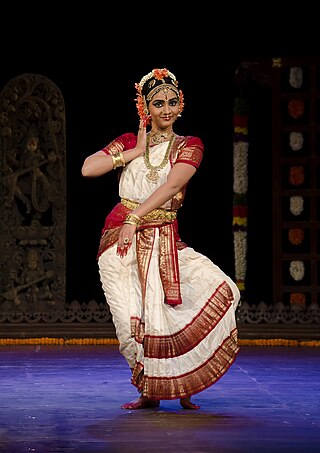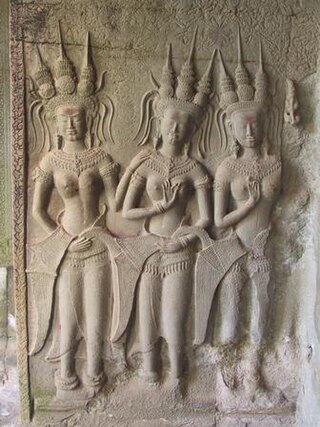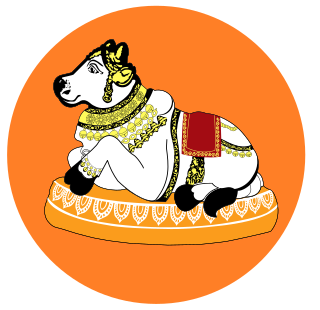
Bharatanatyam is an Indian classical dance form that originated in India. It is a classical dance form recognized by the Sangeet Natak Akademi, and expresses South Indian religious themes and spiritual ideas, of Hinduism and Jainism.

Kathakali is a traditional form of classical Indian dance, and one of the most complex forms of Indian theatre. It is a "story play" genre of art, but one distinguished by the elaborately colourful make-up and costumes of the traditional male actor-dancers. It is native to the Malayalam-speaking southwestern region of Kerala and is almost entirely practiced by Malayali people.

Kuchipudi is one of the eight major Indian classical dances. It originates from a village named Kuchipudi in the Indian state of Andhra Pradesh. Kuchipudi is a dance-drama performance, with its roots in the ancient Hindu Sanskrit text of Natya Shastra. It developed as a religious art linked to traveling bards, temples and spiritual beliefs, like all major classical dances of India.

Odissi, also referred to as Orissi in old literature, is a major ancient Indian classical dance that originated in the temples of Odisha – an eastern coastal state of India. Odissi, in its history, was performed predominantly by women, and expressed religious stories and spiritual ideas, particularly of Vaishnavism through songs written and composed according to the ragas & talas of Odissi music by ancient poets of the state. Odissi performances have also expressed ideas of other traditions such as those related to Hindu deities Shiva and Surya, as well as Hindu goddesses (Shaktism).

Yakshagana is a traditional theatre, developed in Dakshina Kannada, Udupi, Uttara Kannada, Shimoga and western parts of Chikmagalur districts, in the state of Karnataka and in Kasaragod district in Kerala that combines dance, music, dialogue, costume, make-up, and stage techniques with a unique style and form. It is believed to have evolved from pre-classical music and theatre during the period of the Bhakti movement. It is sometimes simply called "Aata" or āṭa. This theatre style is mainly found in coastal regions of Karnataka in various forms. Towards the south from Dakshina Kannada to Kasaragod of Tulu Nadu region, the form of Yakshagana is called Thenku thittu and towards the north from Udupi up to Uttara Kannada it is called Badaga thittu. Both of these forms are equally played all over the region. Yakshagana is traditionally presented from dusk to dawn. Its stories are drawn from Ramayana, Mahabharata, Bhagavata and other epics from both Hindu and Jain and other ancient Indic traditions.

Indian classical dance, or Shastriya Nritya, is an umbrella term for different regionally-specific Indian classical dance traditions, rooted in predominantly Hindu musical theatre performance, the theory and practice of which can be traced to the Sanskrit text Natya Shastra. The number of Indian classical dance styles ranges from six to eight to twelve, or more, depending on the source and scholar; the main organisation for Indian arts preservation, the Sangeet Natak Academy recognizes eight: Bharatanatyam, Kathak, Kuchipudi, Odissi, Kathakali, Sattriya, Manipuri and Mohiniyattam. Additionally, the Indian Ministry of Culture includes Chhau in its list, recognising nine total styles. Scholars such as Drid Williams add Chhau, Yakshagana and Bhagavata Mela to the list. Each dance tradition originates and comes from a different state and/or region of India; for example, Bharatanatyam is from Tamil Nadu in the south of India, Odissi is from the east coast state of Odisha, and Manipuri is from the northeastern state of Manipur. The music associated with these different dance performances consists many compositions in Hindi, Malayalam, Meitei (Manipuri), Sanskrit, Tamil, Odia, Telugu, and many other Indian-Subcontinent languages; they represent a unity of core ideas, and a diversity of styles, costumes and expression.

Temple dance denotes a religious performance held in the temples, such as sadir, prescribed by Agamas. Traces of these ancient temple dances of India are seen in Bharatanatyam and Odissi.

Dance in India comprises numerous styles of dances, generally classified as classical or folk. As with other aspects of Indian culture, different forms of dances originated in different parts of India, developed according to the local traditions and also imbibed elements from other parts of the country.

The Royal Ballet of Cambodia is a classical Khmer dance renowned for its graceful hand movements and luxurious costumes. The ballet has been closely associated with the Khmer court for over a thousand years and would traditionally accompany various royal ceremonies, including coronations, weddings, funerals, and Khmer holidays. The ballet's repertoire encompasses various ancient Khmer legends.

Telugu literature is the body of works written in the Telugu language. It consists of poems, short stories, novels, plays, and song lyrics, among others. There is some indication that Telugu literature dates at least to the middle of the first millennium, the first extant works are from the 11th century when the Mahabharata was first translated to Telugu from Sanskrit by Nannaya. The language has experienced a golden age under the patronage of the Vijayanagara Emperor-Poet Krishnadevaraya.

Chakyar Koothu is a performance art from Kerala, India. It is primarily a type of highly refined monologue where the performer narrates episodes from Hindu epics and stories from the Puranas. Sometimes, however, it is also a traditional equivalent of the modern stand-up comedy act, incorporating commentary on current socio-political events.

The Jangam or Jangamaru are a Shaiva order of religious monks. They are the priests (Gurus) of the Hindu Shaiva sect, Gurus of Veerashaiva sect and are disciples of Shiva as mentioned in Basava Puranas. The meaning of word Jangam is 'moving linga'. Jangama is one who is endowed with true spirit of Agamic knowledge, and has sacrificed his life for giving Samskara (good) character building practices in all sections of the Hindu society.
The dance forms of Andhra Pradesh take on a wide variety of colors, costumes, and types; and involve different settings and musical instruments.
The Haridaasas, the Vaishnava saints of Karnataka, are classified into the Vyaasakuta and Daasakuta. The Vyaasakuta were the pontifical saints known for their scholarship and exposition of Madhva's philosophy. The Daasakuta were the peripatetic saint disciples of the Vyaasakuta sanyasins. They were proficient singers and composers and used classical music and the Kannada language as a medium to propagate the teachings and philosophy of the Dvaita school. While Sripadaraya is sometimes credited with starting this musical movement, Purandaradaasa, a disciple of Vyaasasraaya, became renowned as Karnataka Sangita Pitaamaha.

The culture of Andhra Pradesh embodies some very exclusive and special entities.

The Melattur style of Bharatanatyam dance was developed largely out of the devadasi traditions and Melattur Bhagavata Mela by Mangudi Dorairaja Iyer (1900–1980), a sanyasi following Srividya Upasana.

Perini Shivathandavam or Perini Thandavam is an ancient dance form from Telangana which has been revived in recent time. It prospered during the Kakatiya dynasty. Perini is performed in honour of Lord Shiva, the Hindu God and it is believed that in ancient times this was performed before the soldiers set to war. Nataraja Ramakrishna revived the art form by studying old manuscripts and sculptures at Ramappa Temple.
Nataraja Ramakrishna was an Indian dance guru. He was the chairman of Andhra Pradesh Sangeeta Nataka Academy. He was also a scholar and musicologist who promoted classical dance in Andhra Pradesh and worldwide.

K. Uma Rama Rao was an Indian Kuchipudi dancer, choreographer, research scholar, author and dance teacher. She was also the Founder & Director of Lasya Priya Dance Academy, established in 1985 in Hyderabad, India.
Bhagavata Mela is a classical Indian dance that is performed in Tamil Nadu, particularly the Thanjavur area. It is choreographed as an annual Vaishnavism tradition in Melattur and nearby regions, and celebrated as a dance-drama performance art. The dance art has roots in a historic migration of practitioners of Kuchipudi, another Indian classical dance art, from Andhra Pradesh to the kingdom of Tanjavur.














